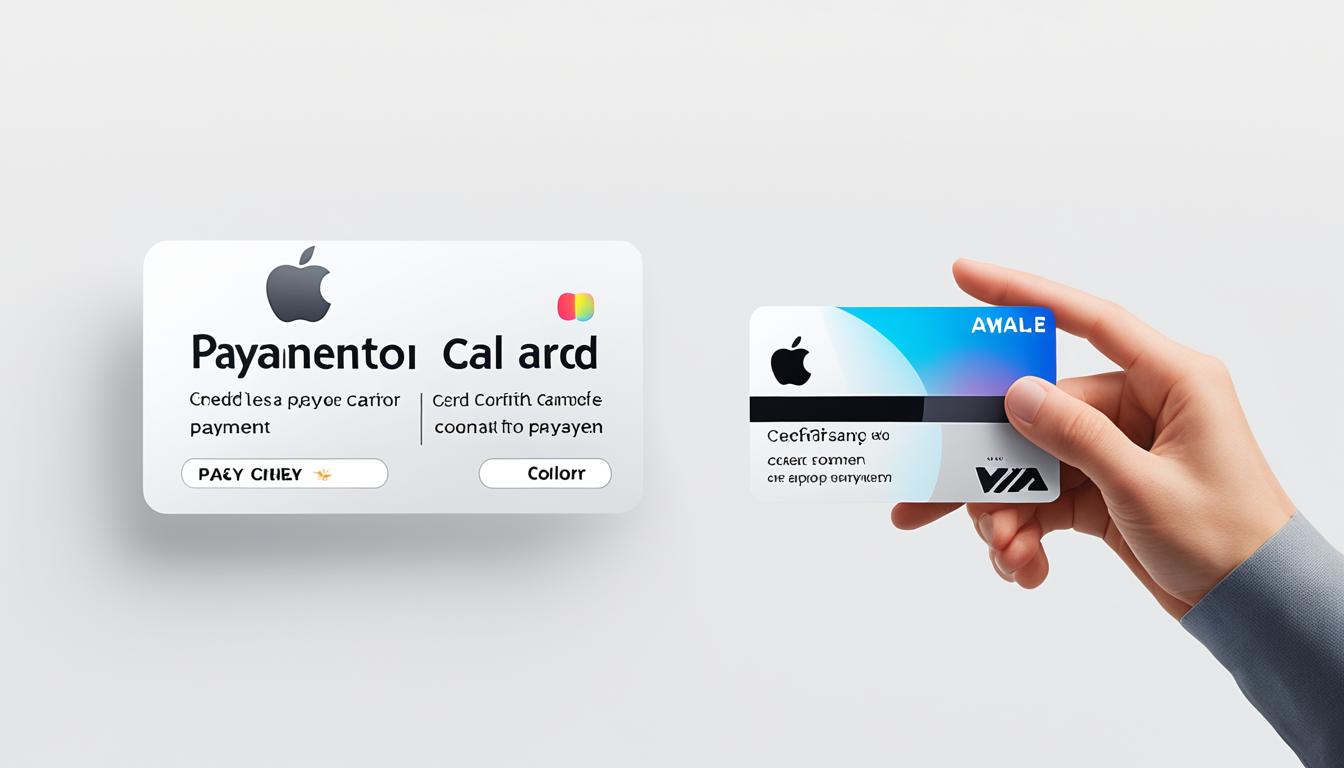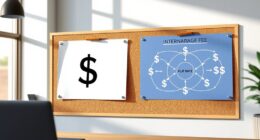Did you know that many people struggle with canceling recurring payments and stopping automatic charges? Whether it’s subscriptions, payment plans, or recurring billing, stopping payments can be difficult for many. But don’t worry, because in this simple guide, I will show you how to stop payments and cancel subscriptions easily, giving you the freedom and control over your finances that you deserve.
Key Takeaways:
- Stopping recurring payments and canceling subscriptions is essential to regain control over your finances.
- By taking simple steps and following the right processes, you can easily terminate automatic charges and payment plans.
- Understanding the different methods for stopping payments, such as through service providers, card issuers, or payment service providers, is key to achieving your goal.
- Utilizing tools and resources like Pay.com can streamline the process and help you manage payments efficiently.
- Remember, you have the power to stop payments and take control of your financial future!
What Are Recurring Payments?
Recurring payments, also known as automatic payments, provide a convenient solution for both businesses and customers. These payment arrangements eliminate the need for businesses to send individual invoices and allow them to seamlessly bill customers at regular intervals. Customers provide their billing information once, and the business debits their account automatically at the agreed-upon time.
There are two types of recurring payments: fixed and variable. In fixed recurring payments, the amount charged remains the same for each billing cycle. This is commonly used for subscriptions with a set monthly fee. On the other hand, variable recurring payments involve charges that fluctuate with each billing cycle. This model is often utilized by businesses offering products or services with varying costs.
Benefits of Recurring Payments
– Convenience: With recurring payments, customers don’t have to manually initiate each transaction, saving them time and effort.
– Financial predictability: Businesses can rely on recurring payments to maintain a steady cash flow, making it easier to plan and budget.
– Improved customer experience: By streamlining the payment process, recurring payments enhance convenience for customers, increasing satisfaction and loyalty.
– Flexibility: Depending on the business’s needs, different billing intervals can be set, such as monthly, quarterly, or annually.
Image:
https://www.youtube.com/watch?v=aFvm-k_ZFUo
| Advantages of Recurring Payments | Disadvantages of Recurring Payments |
|---|---|
| 1. Simplifies billing process for businesses | 1. Requires customers to provide payment details upfront |
| 2. Automates payment collection and reduces administrative tasks | 2. May result in unexpected charges if not carefully monitored |
| 3. Improves cash flow and financial stability for businesses | 3. Can be challenging to cancel or modify recurring payments |
| 4. Enhances customer satisfaction and loyalty | 4. Requires regular communication and security measures to maintain customer trust |
Overall, recurring payments offer a convenient, efficient, and mutually beneficial payment solution for businesses and customers alike. By implementing recurring payments, businesses can streamline their billing processes and maintain a steady cash flow, while customers enjoy the convenience and peace of mind that comes with automatic payments.
How to Stop Recurring Payments on a Credit Card or Debit Card
To stop recurring payments on a credit card or debit card, there are a few simple steps you can take. The first step is to reach out to the company directly and cancel your subscription with them. This can typically be done online or over the phone.
Pro Tip: Check the company’s cancellation policy to ensure you meet any required notice periods or deadlines.
If cancellation with the company is not successful, don’t worry. You still have options. The next step is to contact your bank or card issuer to cancel the payment. They have the authority to revoke the authorization that allows the company to charge your card.
Important: Make sure to communicate your consent withdrawal clearly to the bank or card issuer to prevent any misunderstandings.
The withdrawal of consent and the ability to stop future payments can usually be done up until the day before the payment is due. However, it’s always best to act as soon as possible to avoid any complications.
If further payments are taken from your account after cancellation, don’t worry. According to regulations, the bank or card issuer is responsible for refunding those payments to you.
Steps to Stop Recurring Payments on a Credit Card or Debit Card
| Step | Action |
|---|---|
| 1 | Cancel subscription with the company directly |
| 2 | Contact bank or card issuer to cancel the payment |
| 3 | Withdraw consent to prevent future payments |
| 4 | Monitor account for any further charges |
| 5 | Contact bank or card issuer for refunds, if necessary |
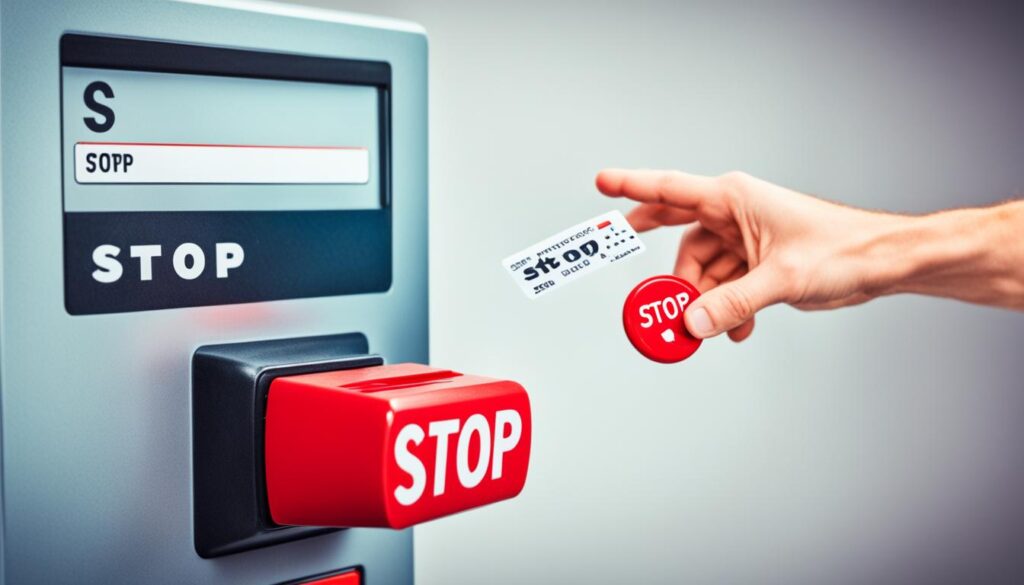
By following these steps, you can confidently stop recurring payments on your credit card or debit card. Remember, it’s important to take action as soon as possible to avoid any further charges. And if you encounter any issues, don’t hesitate to reach out to your bank or card issuer for support.
How to Stop Recurring Payments on PayPal
If you’re looking to stop recurring payments or cancel a subscription on PayPal, you’re in luck! PayPal offers a convenient and user-friendly solution for managing automatic payments. Let me guide you through the process step-by-step.
Managing Subscriptions on PayPal
To manage your recurring payments or cancel a subscription, follow these simple steps:
- Log in to your PayPal account.
- Click on the Settings icon, located at the top right corner of the page.
- From the dropdown menu, select Payments and then choose Manage automatic payments.
- You will see a list of your active subscriptions. Locate the subscription you wish to cancel and click on it.
- On the subscription details page, you will find an option to Cancel the subscription. Click on it.
- Follow any additional prompts or confirmations to complete the cancellation process.
It’s important to note that canceling a subscription on PayPal will not automatically refund any payments already made. Be sure to pay the company for any goods or services you have received before canceling the subscription.
| Benefits of Canceling Subscriptions on PayPal | Considerations |
|---|---|
|
|
Canceling a subscription on PayPal is a breeze! With just a few clicks, you can take control of your recurring payments and manage your automatic charges with ease. Whether it’s for a streaming service, membership, or any other recurring payment, PayPal provides a seamless solution.

How to Cancel Recurring Payments for Online Subscription Services and Apps
When it comes to online subscription services and apps, canceling a recurring payment is often hassle-free and straightforward. These services usually offer flexible cancellation policies, making it quick and easy to cancel your subscription. If you no longer wish to continue with a particular subscription, follow the simple steps below to cancel it:
- Log into your account: Visit the website or open the app and log in using your username and password.
- Access the subscriptions page: Look for the section that lists all your subscriptions or a similar page that manages your account settings.
- Select the subscription to cancel: Find the specific subscription you want to cancel from the list. It might have a name or description associated with it to help you identify it.
- Click the cancel or manage button: Look for a button or link next to the subscription that allows you to cancel or manage it.
- Confirm the cancellation: Follow the prompts or instructions provided to confirm the cancellation. Some services may ask you for additional information or confirmation before processing the cancellation.
It’s important to note that most service providers keep your account or subscription active until the next billing date, even after canceling. This ensures that you can still access and enjoy the service until your subscription period ends. Canceling your subscription in advance will prevent any future charges and ensure a smooth transition.
“Canceling online subscriptions and apps has never been easier. Just a few clicks, and you’re free from recurring payments!”

With these simple steps, you can take control of your online subscriptions and apps. Whether you’re trying out new services or no longer find them useful, canceling recurring payments is a breeze.
How to Stop Automatic Payments from Your Bank Account
Stopping automatic payments from your bank account is a straightforward process that requires direct communication with the company and your bank. By following the steps outlined below, you can regain control of your finances and prevent unwanted charges.
Step 1: Contact the Company
The first step is to reach out to the company or service provider directly. Inform them of your decision to stop automatic payments and request the cancellation of your subscription or payment plan.
Step 2: Revoke Authorization with Your Bank
Next, contact your bank or card issuer to revoke authorization for the automatic payment. You can do this by requesting a stop payment order or revoking consent for future charges. Provide them with the necessary details and documentation to facilitate the process.
Step 3: Monitor Your Accounts
Once you have taken the necessary steps to stop automatic payments, it is crucial to monitor your bank accounts and credit card statements. Ensure that the cancellation has been processed correctly and that no further charges are debited from your account.
By following these steps, you can stop automatic payments from your bank account and regain control over your finances. Remember to keep a record of all communication with the company and your bank for future reference.

The Benefits of Using Pay.com as Your Payment Service Provider
When it comes to accepting recurring payments, Pay.com is a top-notch payment service provider that offers a simple and efficient solution for businesses. With Pay.com, managing payments becomes a breeze, allowing you to focus on what matters most – growing your business.
One of the standout features of Pay.com is the Pay Dashboard, a powerful tool that enables you to track payments and manage refund requests effortlessly. This intuitive dashboard gives you full visibility into your transaction history, making it easy to stay on top of your financials and keep track of your revenue.
Accepted payment methods are crucial for providing a seamless payment experience to your customers, and Pay.com has you covered. Whether it’s credit cards, debit cards, or digital wallets, Pay.com ensures that you can accept payments in the most convenient and secure way possible.
Here’s a breakdown of the benefits you’ll enjoy when choosing Pay.com as your payment service provider:
- Streamlined recurring payments process
- Effortless tracking of payments and revenue
- Easy management of refund requests
- Seamless acceptance of various payment methods
With Pay.com, you can say goodbye to complicated payment processes and hello to a simplified and efficient solution. It’s time to take control of your payments and provide your customers with a seamless experience they’ll love.
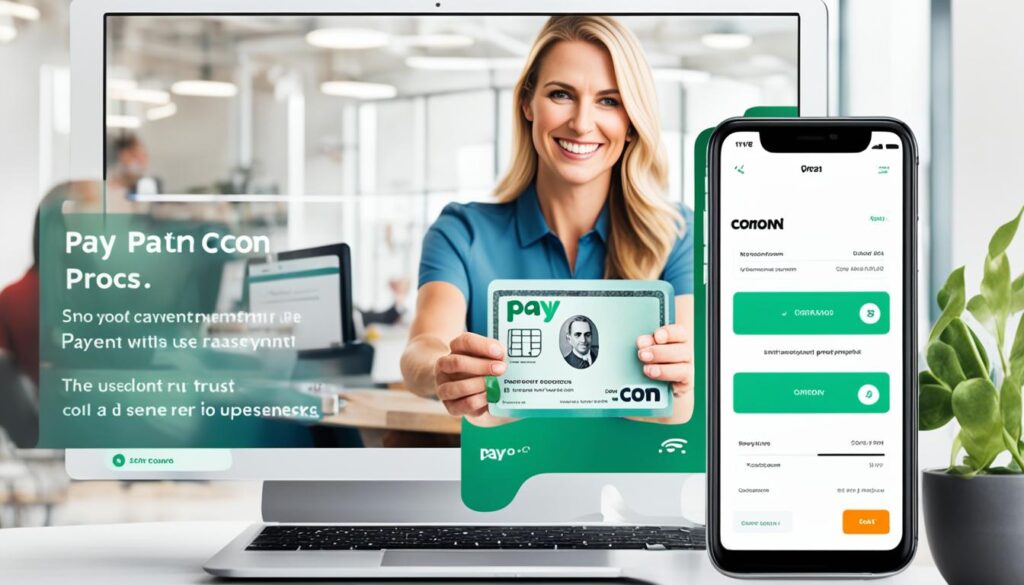
| Benefits of Using Pay.com |
|---|
| Streamlined recurring payments process |
| Effortless tracking of payments and revenue |
| Easy management of refund requests |
| Seamless acceptance of various payment methods |
The Bottom Line: Stopping Recurring Payments Can Be Easy
While recurring payments offer convenience, canceling them can be easy. Whether you’re tired of an unnecessary subscription or want to explore alternative payment methods, taking control of your finances is within reach. Here’s a breakdown of how to stop recurring payments and navigate the cancellation process:
- Email or Website Request: In most cases, canceling recurring payments can be done through a simple request via email or the company’s website. Locate the contact information or customer support page, and submit a cancellation request stating your intention to stop the payments. Be sure to provide any necessary account details for a smooth process.
- Payment Methods: The payment method you used to set up the recurring payments will determine the cancellation process. If you used a credit card or debit card, you might need to contact your card issuer or bank to revoke the authorization for future payments. For those who prefer third-party payment services like PayPal, canceling recurring payments can often be managed directly through the platform’s settings.
- Refunds: In the event that a cancellation is not processed correctly or payments continue after a request, refunds may be requested. This is especially relevant when using payment services like Pay.com, which provides an easy solution for managing recurring payments.
Take the First Step Towards Financial Freedom
By stopping recurring payments and taking charge of your finances, you can regain control over your budget and prioritize your spending effectively.
Whether you choose to cancel subscriptions, explore alternative payment options, or seek refunds, remember that you have the power to make decisions that align with your financial goals. Take advantage of the convenience and ease that technology provides, but always stay informed about your payment methods and keep track of your transactions.
For a visual representation of the cancellation process, refer to the table below:
| Payment Method | Cancellation Process | Refund Policy |
|---|---|---|
| Credit Card/Debit Card | Contact card issuer or bank to revoke authorization | Contact bank for potential refunds |
| Third-Party Payment Services (e.g., PayPal) | Manage automatic payments through platform settings | Contact customer support for potential refunds |
Remember, stopping recurring payments is just the first step. Make sure to assess your spending habits, evaluate your financial priorities, and align your budget accordingly. With determination and a clear plan, you can achieve financial freedom and take control of your financial future.
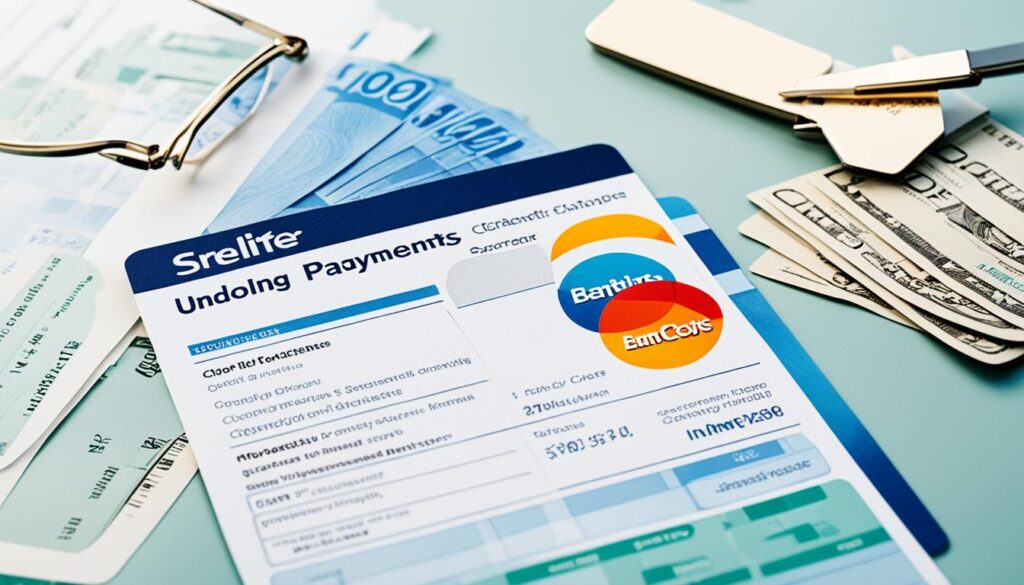
Creating Your Own Get-Out-of-Debt Plan
Getting out of debt is a journey that requires commitment, careful planning, and making necessary lifestyle changes. Even if you have a low income, it is possible to create a debt repayment plan and achieve financial freedom. The key to success lies in reshaping your attitudes towards money and debt, understanding the true cost of borrowing, and avoiding new debt.
Creating a get-out-of-debt plan starts with a clear understanding of your financial situation. Take a close look at your income, expenses, and debts. Identify areas where you can make budget cuts and reduce unnecessary spending. This step will lay the foundation for your debt repayment journey.
Commitment and Mindset Shift
Getting out of debt requires a strong commitment to change your financial situation. You must be willing to make sacrifices and prioritize debt repayment over non-essential expenses. Adopting a positive mindset and staying motivated throughout the process is essential to overcome challenges along the way.
“The future rewards those who press on. I don’t have time to feel sorry for myself. I don’t have time to complain. I’m going to press on.” – Barack Obama
Creating a Debt Repayment Plan
A debt repayment plan will serve as your roadmap to financial freedom. Start by listing all your debts, including credit cards, loans, and any other outstanding balances. Sort them by interest rate or balance, depending on your preferred repayment strategy.
Consider using the debt snowball method, where you focus on paying off the smallest debt first while making minimum payments on the rest. Once the smallest debt is paid off, allocate the extra funds towards the next smallest debt. This strategy builds momentum and keeps you motivated throughout the process.
Alternatively, you can use the debt avalanche method, where you prioritize debts with the highest interest rates. By tackling high-interest debts first, you minimize the amount of interest paid over time.
Lifestyle Changes and Financial Planning
As you work on your debt repayment plan, it’s crucial to make lifestyle changes that promote financial stability. This may include cutting back on discretionary expenses, finding ways to increase your income, and avoiding unnecessary debt.

Creating a realistic budget will help you track your income and expenses, ensuring that you have enough money to cover your basic needs while making consistent debt payments. Consider using budgeting apps or financial management tools to simplify the process.
The Power of Planning
Remember, getting out of debt is not an overnight process. It requires patience, discipline, and a well-executed plan. Stay focused on your financial goals, celebrate small victories along the way, and seek support from family and friends if needed.
| Steps to Create Your Get-Out-of-Debt Plan |
|---|
| 1. Evaluate your financial situation |
| 2. Make a commitment to change |
| 3. Create a debt repayment plan |
| 4. Consider debt repayment strategies (debt snowball or debt avalanche) |
| 5. Implement lifestyle changes to improve financial stability |
| 6. Develop a realistic budget |
| 7. Stay motivated and track your progress |
Stop Borrowing Money
When it comes to getting out of debt, one of the most important steps to take is to stop borrowing money. It’s time to reshape our attitude towards money and debt and make necessary lifestyle changes to break free from the cycle of borrowing.
If you’re relying heavily on credit cards, it’s crucial to reassess your spending habits and make a conscious effort to use them sparingly. Credit cards may provide convenience, but they often come with high-interest rates and can quickly lead to overwhelming debt. Instead, let’s focus on living within our means and making purchases with the money we already have.
Similarly, be cautious when considering loans. Although loans may seem like a quick fix for financial emergencies or large purchases, they can easily become a burden. Understand the true cost of loans, including interest rates and potential fees, before taking on additional debt.
Before turning to debt consolidation or balance transfers, prioritize avoiding new debt altogether. These strategies may seem appealing initially, but they can only be effective when combined with lifestyle changes and a commitment to stop borrowing money.
Living on a Cash Basis
A practical approach to stop borrowing money is to start living on a cash basis. By relying on cash for everyday expenses, we can better manage our finances and minimize the temptation to overspend. It allows us to have a clearer picture of our money and avoid accumulating more debt.
“Living on a cash basis is not about depriving ourselves of the things we want; it’s about making intentional choices and aligning our spending with our financial goals.”
When using cash, we become more aware of the value of money and are less likely to make impulsive purchases. By planning our spending in advance and sticking to a budget, we can regain control over our financial situation.
Understanding the True Cost of Credit Cards and Loans
Another crucial aspect of getting out of debt is understanding the true cost of credit cards and loans. Credit card interest rates can be surprisingly high, making it easy for debt to accumulate if payments are not made in full each month. If we continue using credit cards without considering the long-term consequences, we may find ourselves trapped in a cycle of debt.
Similarly, loans come with interest and fees that can significantly increase their overall cost. Before taking on a loan, carefully assess the terms and conditions, and ensure you can comfortably afford the monthly payments without jeopardizing your financial stability.
By gaining a clear understanding of the true cost of credit cards and loans, we can make informed decisions and prioritize paying off existing debt over accumulating new debt.

| The Importance of Stopping Borrowing Money |
|---|
| 1. Break free from the cycle of debt |
| 2. Regain control over your finances |
| 3. Minimize interest charges and fees |
| 4. Avoid accumulating more debt |
Reshaping our attitude towards money, living on a cash basis, and understanding the true cost of credit cards and loans are essential steps in the journey towards financial freedom. By taking control of our finances and implementing these lifestyle changes, we can successfully stop borrowing money and pave the way for a debt-free future.
Track Your Spending
Tracking your spending is a crucial step in gaining control over your finances. By monitoring your expenses, you can identify areas where you can reduce costs and save money. There are various methods you can use to track your spending:
- Budget Worksheets: Utilize budget worksheets to record and categorize your expenses. These worksheets provide a structured framework for tracking your spending and offer insights into your financial habits.
- Notes in a Notebook: Keep a dedicated notebook to jot down your daily expenses. This method allows you to quickly record your spending and easily identify patterns or areas where you tend to overspend.
- Money Management Apps: Take advantage of mobile apps specifically designed to track and manage your finances. These apps provide a convenient way to monitor your expenses, organize your budget, and set financial goals.
- Receipts: Keep track of your receipts for all purchases, big or small. Not only do receipts serve as evidence of your transactions, but they also help in reconciling your actual spending with your recorded expenses.
By diligently tracking both your monthly bills and your daily spending, you’ll gain a comprehensive understanding of where your money goes. This knowledge empowers you to make informed decisions about spending cuts and prioritize your financial goals.
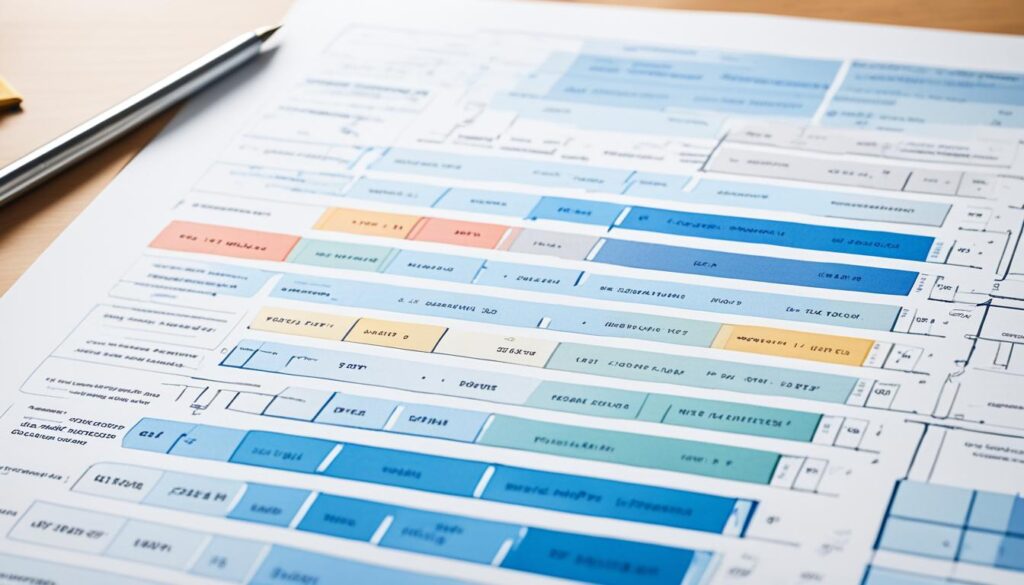
The Benefits of Tracking Your Spending
“When you track your spending, you take control of your money and become more mindful of your financial habits.”
Tracking your spending offers several benefits:
- Financial Awareness: By tracking your expenses, you become more aware of your spending habits and can identify areas where you can make adjustments to achieve your financial goals.
- Budget Optimization: Tracking your spending enables you to refine your budget and allocate resources more efficiently. It helps you identify unnecessary expenses and redirect those funds towards savings or other financial priorities.
- Debt Reduction: Understanding your spending patterns allows you to prioritize debt repayment. By reallocating funds from non-essential expenses, you can accelerate your debt reduction and achieve financial freedom sooner.
- Financial Stability: By keeping a watchful eye on your spending, you can avoid overspending and ensure that your expenses are in line with your income. This promotes financial stability and reduces the risk of accumulating debt.
Remember, tracking your spending is not intended to restrict your financial freedom but rather to empower you to make conscious decisions about your money. It’s a tool that puts you in control of your finances and helps you achieve your financial goals.
Set up a Budget
Creating a budget is a fundamental step in managing your finances effectively. It allows you to take control of your spending and ensure that your financial goals are on track. By outlining your income and expenses, you can strike a balance between meeting your needs and making necessary spending cuts.
When setting up a budget, it’s important to identify your needs and prioritize them. Focus on essential expenses like housing, utilities, transportation, and groceries. These are the non-negotiables that must be accounted for in your budget. By allocating a portion of your income towards these needs, you can ensure that your basic necessities are covered.
Next, evaluate your discretionary spending and identify areas where you can make spending cuts. Look for opportunities to eliminate unnecessary expenses or find more cost-effective alternatives. This could mean cutting down on dining out, entertainment, or non-essential subscriptions. Remember, small savings in multiple areas can add up and contribute to your overall financial well-being.
Striking a balance between a livable budget and strict spending limits is crucial. While it’s important to be mindful of your financial goals, you also need to allow yourself some breathing room and flexibility. Consider setting aside a portion of your budget for occasional treats or personal indulgences. This allows you to maintain a sense of balance and avoid feeling deprived.
Writing down your financial goals and referring to them regularly can provide the motivation and focus needed to stay on track. Visualize what you want to achieve, whether it’s paying off debt, saving for a house, or building an emergency fund. By keeping your goals in mind, you’ll be more inclined to make the necessary financial decisions that will help you achieve them.
Finally, don’t forget to include an emergency savings fund in your budget. Life is unpredictable, and having a dedicated fund to cover unexpected expenses can provide peace of mind. Aim to set aside a portion of your income each month for your emergency fund, gradually building it up to cover 3-6 months’ worth of expenses.
Summary:
Setting up a budget is essential for effective financial management. By accounting for your needs, making spending cuts, and balancing your budget, you can achieve your financial goals. Writing down your goals and building an emergency savings fund are key steps towards financial stability and peace of mind.

Create a Plan to Pay Off Debt: Try a Debt Snowball Method
When it comes to paying off debt, having a solid plan in place is essential for success. One effective strategy to consider is the debt snowball method. This approach involves directing extra funds towards one debt while making minimum payments on others. As each debt is paid off, the extra funds are then reallocated to the next debt, gradually building momentum and creating a “snowball” effect.
The debt snowball method offers several advantages. First, it provides a clear and structured repayment strategy, helping individuals stay focused and motivated. By starting with smaller debts and gradually working towards larger ones, you gain a sense of accomplishment along the way.
Here’s a step-by-step guide to implementing the debt snowball method:
- List all of your debts, including credit cards, loans, and other outstanding balances. Include the total balance and the minimum monthly payment for each.
- Order your debts from smallest to largest based on the total balance.
- Designate a specific amount of extra funds each month to put towards debt repayment.
- Make minimum payments on all debts.
- Direct the extra funds towards the debt with the smallest balance.
- Continue this process, focusing on one debt at a time until it is paid off.
- Once a debt is paid off, funnel the entire amount that was going towards that debt towards the next smallest balance.
- Repeat this process until all debts are paid off.
“The debt snowball method allowed me to pay off my debts more quickly than I ever thought possible. Seeing progress with every debt I paid off kept me motivated and gave me the confidence I needed to keep going.” – Sarah Johnson
Remember, the key to success with the debt snowball method is consistency and discipline. Stick to your plan, allocate extra funds towards debt repayment, and avoid accumulating new debts. Over time, you’ll see your debts decrease and your financial freedom increase.

| Debt | Total Balance | Minimum Monthly Payment |
|---|---|---|
| Credit Card A | $2,500 | $50 |
| Credit Card B | $5,000 | $100 |
| Student Loan | $15,000 | $200 |
| Car Loan | $20,000 | $300 |
Table: Example Debt Snowball Plan
By applying the debt snowball method to the example debts above, the individual would start by focusing on paying off Credit Card A first. They would make the minimum payments on Credit Card B, the student loan, and the car loan. Once Credit Card A is paid off, the monthly payment that was going towards it ($50) would be redirected towards Credit Card B, along with the minimum payment. This process continues until all debts are fully repaid, accelerating the debt payoff and creating a sense of accomplishment along the way.
Conclusion
In conclusion, achieving financial freedom and getting out of debt requires commitment, planning, and discipline. By following the steps outlined in this guide to stop payments and create a debt repayment plan, individuals can take control of their finances and work towards a debt-free future.
To simplify the payment process and effectively manage payments, utilizing a payment service provider like Pay.com can be highly beneficial. Pay.com offers a user-friendly platform that allows businesses to track payments, manage refunds, and accept various payment methods, making it easier for both businesses and customers.
Remember, the road to financial freedom may not always be easy, but with determination and the right tools, it is achievable. Take charge of your finances, stop recurring payments, and develop a plan to pay off debt. With a clear strategy, you can overcome financial challenges and pave the way to a brighter, debt-free future.
FAQ
How can I stop recurring payments?
What are recurring payments?
How do I stop recurring payments on a credit card or debit card?
How can I stop recurring payments on PayPal?
How do I cancel recurring payments for online subscription services and apps?
How can I stop automatic payments from my bank account?
What are the benefits of using Pay.com as my payment service provider?
Is canceling recurring payments easy?
How can I create my own get-out-of-debt plan?
What is the first step in getting out of debt?
How can tracking spending help me get out of debt?
How do I set up a budget to manage my debt?
What is the debt snowball method?
How can utilizing a payment service provider help with debt repayment?
Can I Use the Stop Payments Fast Guide to Switch My Payment Frequency Easily?
Yes, the Stop Payments Fast Guide provides an easy way to change your payment frequency switching options. With just a few simple steps, you can adjust the frequency of your payments to better suit your needs. It’s a quick and convenient way to manage your finances more efficiently.


